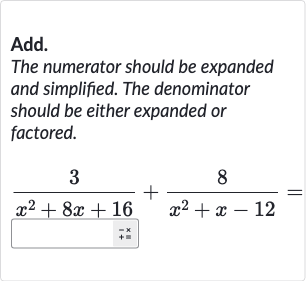Full solution
Q. Add.The numerator should be expanded and simplified. The denominator should be either expanded or factored.
- Identify denominators: Identify the denominators of both fractions to determine if they can be factored.The first denominator is , which is a perfect square trinomial and can be factored as or .The second denominator is , which can be factored into .
- Write fractions with factored denominators: Write the fractions with their factored denominators. becomes . becomes .
- Find common denominator: Find a common denominator for the two fractions.The least common denominator (LCD) is .
- Rewrite fractions with common denominator: Rewrite each fraction with the common denominator. becomes . becomes .
- Combine fractions over common denominator: Combine the fractions over the common denominator. becomes .
- Simplify numerator: Simplify the numerator by combining like terms. simplifies to .
- Write final simplified fraction: Write the final simplified fraction.The sum of the fractions is .

